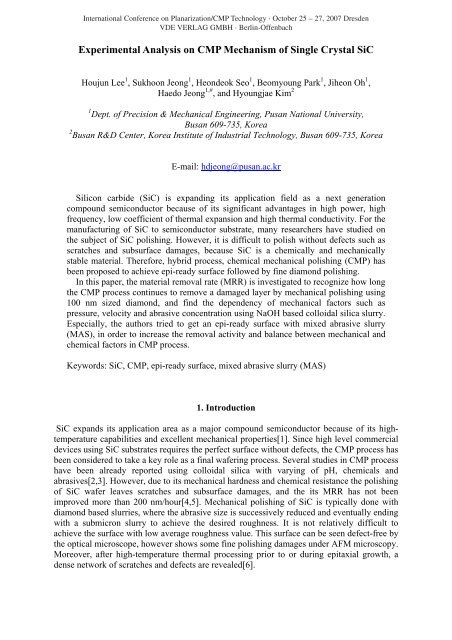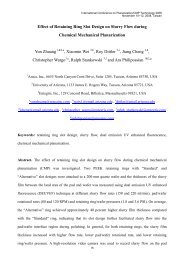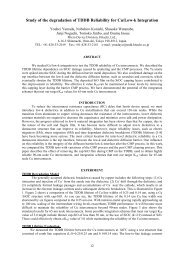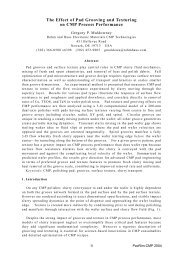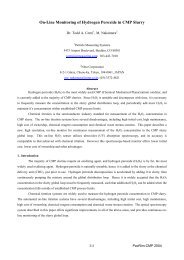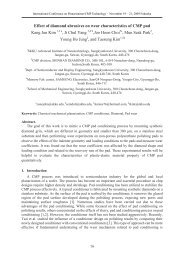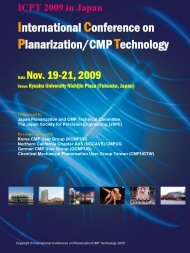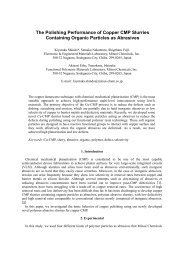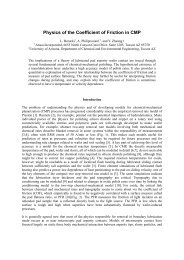Experimental Analysis on CMP Mechanism of Single Crystal SiC
Experimental Analysis on CMP Mechanism of Single Crystal SiC
Experimental Analysis on CMP Mechanism of Single Crystal SiC
You also want an ePaper? Increase the reach of your titles
YUMPU automatically turns print PDFs into web optimized ePapers that Google loves.
Internati<strong>on</strong>al C<strong>on</strong>ference <strong>on</strong> Planarizati<strong>on</strong>/<strong>CMP</strong> Technology · October 25 – 27, 2007 DresdenVDE VERLAG GMBH · Berlin-Offenbach<str<strong>on</strong>g>Experimental</str<strong>on</strong>g> <str<strong>on</strong>g>Analysis</str<strong>on</strong>g> <strong>on</strong> <strong>CMP</strong> <strong>Mechanism</strong> <strong>of</strong> <strong>Single</strong> <strong>Crystal</strong> <strong>SiC</strong>Houjun Lee 1 , Sukho<strong>on</strong> Je<strong>on</strong>g 1 , He<strong>on</strong>deok Seo 1 , Beomyoung Park 1 , Jihe<strong>on</strong> Oh 1 ,Haedo Je<strong>on</strong>g 1,# , and Hyoungjae Kim 21 Dept. <strong>of</strong> Precisi<strong>on</strong> & Mechanical Engineering, Pusan Nati<strong>on</strong>al University,Busan 609-735, Korea2 Busan R&D Center, Korea Institute <strong>of</strong> Industrial Technology, Busan 609-735, KoreaE-mail: hdje<strong>on</strong>g@pusan.ac.krSilic<strong>on</strong> carbide (<strong>SiC</strong>) is expanding its applicati<strong>on</strong> field as a next generati<strong>on</strong>compound semic<strong>on</strong>ductor because <strong>of</strong> its significant advantages in high power, highfrequency, low coefficient <strong>of</strong> thermal expansi<strong>on</strong> and high thermal c<strong>on</strong>ductivity. For themanufacturing <strong>of</strong> <strong>SiC</strong> to semic<strong>on</strong>ductor substrate, many researchers have studied <strong>on</strong>the subject <strong>of</strong> <strong>SiC</strong> polishing. However, it is difficult to polish without defects such asscratches and subsurface damages, because <strong>SiC</strong> is a chemically and mechanicallystable material. Therefore, hybrid process, chemical mechanical polishing (<strong>CMP</strong>) hasbeen proposed to achieve epi-ready surface followed by fine diam<strong>on</strong>d polishing.In this paper, the material removal rate (MRR) is investigated to recognize how l<strong>on</strong>gthe <strong>CMP</strong> process c<strong>on</strong>tinues to remove a damaged layer by mechanical polishing using100 nm sized diam<strong>on</strong>d, and find the dependency <strong>of</strong> mechanical factors such aspressure, velocity and abrasive c<strong>on</strong>centrati<strong>on</strong> using NaOH based colloidal silica slurry.Especially, the authors tried to get an epi-ready surface with mixed abrasive slurry(MAS), in order to increase the removal activity and balance between mechanical andchemical factors in <strong>CMP</strong> process.Keywords: <strong>SiC</strong>, <strong>CMP</strong>, epi-ready surface, mixed abrasive slurry (MAS)1. Introducti<strong>on</strong><strong>SiC</strong> expands its applicati<strong>on</strong> area as a major compound semic<strong>on</strong>ductor because <strong>of</strong> its hightemperaturecapabilities and excellent mechanical properties[1]. Since high level commercialdevices using <strong>SiC</strong> substrates requires the perfect surface without defects, the <strong>CMP</strong> process hasbeen c<strong>on</strong>sidered to take a key role as a final wafering process. Several studies in <strong>CMP</strong> processhave been already reported using colloidal silica with varying <strong>of</strong> pH, chemicals andabrasives[2,3]. However, due to its mechanical hardness and chemical resistance the polishing<strong>of</strong> <strong>SiC</strong> wafer leaves scratches and subsurface damages, and the its MRR has not beenimproved more than 200 nm/hour[4,5]. Mechanical polishing <strong>of</strong> <strong>SiC</strong> is typically d<strong>on</strong>e withdiam<strong>on</strong>d based slurries, where the abrasive size is successively reduced and eventually endingwith a submicr<strong>on</strong> slurry to achieve the desired roughness. It is not relatively difficult toachieve the surface with low average roughness value. This surface can be seen defect-free bythe optical microscope, however shows some fine polishing damages under AFM microscopy.Moreover, after high-temperature thermal processing prior to or during epitaxial growth, adense network <strong>of</strong> scratches and defects are revealed[6].
Internati<strong>on</strong>al C<strong>on</strong>ference <strong>on</strong> Planarizati<strong>on</strong>/<strong>CMP</strong> Technology · October 25 – 27, 2007 DresdenVDE VERLAG GMBH · Berlin-Offenbach( a )( b )( c )( d )( e )Fig. 4. Optical microscope and AFM images : (a) before <strong>CMP</strong>, and after <strong>CMP</strong> using (b) 20wt% colloidal silica slurry, (c) DIW + 25 nm diam<strong>on</strong>d, (d) MAS-I (10 wt% colloidal silicaslurry + 25 nm diam<strong>on</strong>d), and (e) MAS-II (20 wt% colloidal silica slurry + 25 nm diam<strong>on</strong>d)Table 2. <str<strong>on</strong>g>Experimental</str<strong>on</strong>g> c<strong>on</strong>diti<strong>on</strong>sWafer2 inch silic<strong>on</strong> carbide wafer (6H-<strong>SiC</strong> <strong>on</strong>-axis)Pad Felt type pad (Suba 800)VelocityHead 120 rpm / Platen 120 rpmPressure 1.2 kg/cm 2SlurryFlow rateProcess time20 wt% Colloidal silica(KOH base, 120 nm)DIW + 25nm diam<strong>on</strong>dMAS-I(10 wt% Colloidal silica +25 nm diam<strong>on</strong>d)125 ml/min2 hoursMAS-II(20 wt% Colloidal silica+ 25 nm diam<strong>on</strong>d)
Internati<strong>on</strong>al C<strong>on</strong>ference <strong>on</strong> Planarizati<strong>on</strong>/<strong>CMP</strong> Technology · October 25 – 27, 2007 DresdenVDE VERLAG GMBH · Berlin-OffenbachTable 3. Measurement results after <strong>CMP</strong> <strong>of</strong> each c<strong>on</strong>diti<strong>on</strong>Before test(a)20 wt% Slurry(b)DIW + diam<strong>on</strong>d(c)MAS-I(d)MAS-II(e)Ra () 8 10.5 24.8 15.5 2.4Rv (nm) 6 12 23 12 1.2The average roughness value (Ra) before <strong>SiC</strong> <strong>CMP</strong> is 8, and the deepest scratch depth(Rv) is 6 nm <strong>on</strong> n<strong>on</strong>-<strong>CMP</strong> tested <strong>SiC</strong> wafer. The Ra and Rv <strong>of</strong> the measured window range(10 10 ) <strong>of</strong> AFM increased up to 10.5 and 12 nm in the case <strong>of</strong> (b) (20 wt%colloidal silica slurry), respectively. But, the Ra without scratches was down to 2.5,because the shallow scratch after the mechanical polishing is removed by silica abrasives. TheRa and Rv <strong>of</strong> (c) case (diluted suspensi<strong>on</strong> with diam<strong>on</strong>d abrasives) dramatically increased. Itis becuase the diam<strong>on</strong>d abrasives have <strong>on</strong>ly mechanical effect <strong>on</strong> the material removal. Whenthe <strong>SiC</strong> wafer was polished by using mixed abrasive slurry (MAS) which is high mechanicaland high chemical c<strong>on</strong>diti<strong>on</strong>, the Ra and Rv value were 2.4 and 1.2 nm in MAS-II case,respectively. Also, Fig. 4 (e) shows that the scratch effectively reduced. This result isoutstanding in comparis<strong>on</strong> with other experimental c<strong>on</strong>diti<strong>on</strong>s. It is because the diam<strong>on</strong>dabrasives easily remove the reacted layer <strong>on</strong> deeper scratches in KOH based slurry and thesilica abrasives remove the shallow scratches at the same time. However, the MAS-I couldnot improve the surface roughness because <strong>of</strong> the drop <strong>of</strong> ability to remove shallow scratchesaccording to the decrease <strong>of</strong> silica abrasives. Therfore, the balance am<strong>on</strong>g abrasivec<strong>on</strong>centrati<strong>on</strong>, abrasive type and based chemicals in slurry is important to ensure the materialremoval rate for <strong>SiC</strong> <strong>CMP</strong> process.4. C<strong>on</strong>clusi<strong>on</strong>In order to make the surface <strong>of</strong> <strong>SiC</strong> wafer which finished mechanical polishing process int<strong>of</strong>ine surface, it goes through the <strong>CMP</strong> process. Using colloidal silica slurry, if pressure,velocity and c<strong>on</strong>centrati<strong>on</strong> <strong>of</strong> abrasive increased, the MRR goes up as well. However the subsurfacedamage such as deep scratches could not removed, the surface roughness did notimprove. To solve these problems <strong>of</strong> silica, MAS (colloidal silica + diam<strong>on</strong>d) was used in <strong>SiC</strong><strong>CMP</strong>. Increasing <strong>of</strong> a kind energy am<strong>on</strong>g various energies did not work. So, to increasemechanical and chemical energy, MAS was used. The scratch was removed and the surfaceroughness improved <strong>on</strong>ly when using MAS with both mechanical and chemical energiesraised. Through this experiment, the importance <strong>of</strong> mechanical and chemical energy balancewas c<strong>on</strong>firmed. Research <strong>on</strong> finding out the influence through diverse mixed c<strong>on</strong>diti<strong>on</strong>s isneeded.References[1] L. T<strong>on</strong>g, M. Mehregany, L. G. Matus, 5th Technical Digest, IEEE, 198-201 (1992)[2] C. L. Neslen, W. C. Mitchel, R. L. Hengehold, J. Electr<strong>on</strong>. Mater. Vol. 30, 1271 (2001)[3] L. Zhou, V. Audurier, P. Pirouz, J. A. Powell, J. Electrochem. Soc. Vol. 144, L161 (1994)[4] J. C. Zolper, M. Skowr<strong>on</strong>ski, MRS Bulletin, Vol. 30, 273 April (2005)[5] J. A. Powell, D. J. Larkin, P. B. Abel, J. Electr<strong>on</strong>. Mater. Vol. 24, 295 (1995)[6] C. Martin, T. M. Kerr, W. Stepko, T. Anders<strong>on</strong>, Compound semic<strong>on</strong>ductor manufacturingtechnology, .291-294 (2004)


